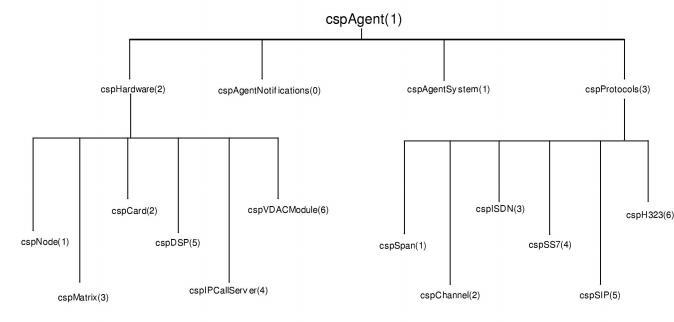
You are here: SwitchKit SNMP User’s Guide > 1 SNMP Introduction > Excel platform SNMP Agent MIB

Overview
For the Management Information Bases (MIBs), all objects are organized into two major groups underneath the node, convergedServicesPlatform (excelProducts 90). The cspAgent group contains all of the notifications, objects, and tables associated with the CSPAgent process. The cspEventManager group contains all of the notifications, objects, and tables associated with the CSPEventManager process.
Important! In this user guide, references to CSPAgent or CSPEventManager (note the capitalization) indicate the executable files. References to cspAgent or cspEventManager indicate the ASN.1 group names in the csp.mib file. In some instances, output from SNMP tools refers to notifications as traps.

cspAgent
This branch is divided into four groups:
|
Group |
Description |
|---|---|
|
cspAgentNotifications(0) |
For all notifications sent by the CSPAgent process |
|
cspAgentSystem(1) |
For agent configuration, the only object currently present is cspAgentSystemVerbose |
|
cspHardware(2) |
Objects describing proprietary CSP hardware (includes chassis, cards, dsps, and matrix cards.) |
|
cspProtocols(3) |
Objects describing public/standard protocol stacks on CSP hardware. (such as, T1, ISDN, and SS7.) |

cspEventManager
This branch is divided into four groups:
|
Group |
Description |
|---|---|
|
cspEventManagerNotifications(0) |
For the connection notifications sent by the CSPEventManager process. |
|
cspEventManagerSystem(1) |
For event manager configuration. Currently, the only object present is cspEventManagerSystemVerbose. |
|
cspEventManagerEvents (2) |
For notifications and cspeventTable used to process most switch-initiated events. |
|
cspPPLEventManagerEvents(3) |
For notifications and pplEventTable used to process the PPL Event Indication message |

Zero-based indexing of tables is not allowed because of the constraint of the ASN.1 syntax in which all SNMP MIBs are defined. All addressing on the Excel platform is zero-based. All addressing information represented as an index in the MIB is one-based, meaning that it has been converted from the zero-based representation on the switch to the one-based MIB representation by adding a one. All index objects in the cspAgent group are represented this way. In other words, if you would like to find out card information about the card in slot 0 on node 5, you would submit a command similar to the following, with the specific indices 6.1:
[c:\]getone -v2c 135.119.36.107 public cspCardType.6.1
cspCardType.6.1 = dsp_one(21)
In the cspEventManager group, addressing of switch entities is handled mostly as variables bound to notifications. As such, these addresses are zero-based because they are not table indices. When the card in slot 0 on node 5 comes into service, the cspCardUp notification would contain the following information:
Received SNMPv2c Trap:
Community: public
From: 127.0.0.1
sysUpTime.0 = 30773
snmpTrapOID.0 = cspCardUp
cspEventNode = 5
cspEventSeverity = informative(1)
cspEventAddressType = slot(3)
cspEventAddressData1 = 0
cspEventStatus = cardInService(5)
The SNMP uses User Datagram Protocol (UDP) as its transport protocol. UDP is not a connection-based, guaranteed delivery network protocol. Therefore, notifications are not guaranteed delivery. So notifications are not always the most reliable way to find out about extraordinary events occurring on a device. Because of this, all switch events are logged and archived by the CSPEventManager process. All switch events are logged to a file named, CSPEventManager.log. The file is created in the directory: $(SK_LOG_DIR), if defined. If SK_LOG_DIR is not defined, this log is created in the directory from which the CSPEventManager process is executed. This log is managed in a similar way to SwitchKit logs. All switch events are archived to either the cspEventTable or the cspPPLEventTable. The cspPPLEventTable archives all occurrences of PPL Event Indication messages. The cspEventTable archives all other switch-initiated messages that are defined as notifications under cspEventNotifications (cspEventManagerEvents 0). Both tables have associated with them a count object and a max object. The count object indicates how many events have been archived in the table at a given time. Count objects are ideal for event polling. The max object indicates the maximum number of events that are archived before the table index rolls over. The max object is a maximum of 500, but is read/writable, and you can set it to as low as ten. You can set this object by issuing the following command at the command line:
setany –v2c localhost cspAdmin cspEventMax.0 –i 300
Addressing information on the switch is handled in the EXS API by a dynamic addressing scheme using Address Information Blocks (AIBs). When event-driven messages arrive from the Excel platform, entities involved in the event are addressed by the AIB. The AddressType textual-convention is an attempt at representing this dynamic scheme in the static environment of ASN.1. AddressType is defined in csp.mib. The AddressType enumerates all of the possible entities, including:
• Some hardware
• Some software that is addressed by alarms
• PPL Event Indications
• Card Status Reports
• Server Status Change messages
An AddressType object is bound to notifications and is archived in the event tables. The address type object is always accompanied by three data objects. The value of these data objects depends on the value of the AddressType Object. For example, in the cspCardUp notification above, cspEventAddressType equals slot(3). The definition of AddressType in csp.mib contains a table that explains the meaning of each data object. For slots, cspEventAddressData1 represents the zero-based slot number.
In the following example, the cspPPLEventAddressType is ss7Link(9). In the AddressType table, it implies that cspPPLEventAddressData1 is the SS7 Stack and cspPPLEventAddressData2 is the SS7Link. Because SS7 Links need only two data objects to represent the address, the third data object is unused and initialized to (-1).
Received SNMPv2c Trap:
Community: public
From: 127.0.0.1
sysUpTime.0 = 191067
snmpTrapOID.0 = cspPPLEvent
cspPPLEventNode = 5
cspPPLEventComponentID = ss7mtp3_lsac(46)
cspPPLEventID = 1
cspPPLEventDescription = PPLEventIndication Evt=0x 1 on LinkID = 1, StackID=0, Comp=0x2E: MTP3 LSAC: Link Activation Failure
cspPPLEventAddressType = ss7Link(9)
cspPPLEventAddressData1 = 0
cspPPLEventAddressData2 = 1
cspPPLEventAddressData3 = -1
To obtain a full list of the CSP MIB objects, you can use your Network Management Station to do a MIB walk.